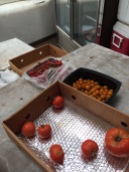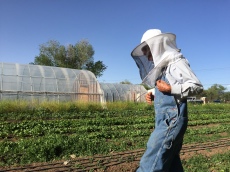The war on bugs has been going on a long time. It is making humans and our earth sick. Sadly, the chemicals impact the whole food chain. All the way to the top.

And unfortunately, the bugs are losing…though many humans are cheering their extinction. Ultimately, they are only the first in a chain reaction of extinctions.

The flying community messes up our windshields, eats our crops and otherwise fills our invisible air with visible life. But sadly, it’s not just the pesky ones we are saying good bye to, it’s also the multitudinous beneficials—some whom we will never meet in our gardens. The pesky pests will continue to re-invent themselves and become resistant and resilient to all our chemicals. It’s the more vulnerable beneficials that we need for our gardens to grow, that we must fall in love with— bees, lady bugs, green lacewings, praying mantis’, and many more.


They are the ones that worry me. Once they are gone, our natural insurance against massive pestilence and any hope in balancing the eco-system we have so destroyed, becomes alot harder. Chemical companies will be delighted to have our business, once the bio-force of bugs is gone.

So much to lament.
Scientists have raised the alarm after a study 27 years in the making found the biomass of flying insects in nature protected areas has declined by more than 75% since 1990. The causes of the decline are not fully understood.
The decline of Europe’s bee populations has been on policy-makers’ radars for some time. Less attention has been paid to the plight of other flying insects but a study published in scientific journal Plos One in October has revealed that they too have declined in both diversity and abundance in the last quarter of a century…
Flying insects are a vital part of many ecosystems: they pollinate 80% of plant species and some 60% of birds rely on them as a source of food. They are also an important source of protein for many mammals and a key part of the nutrient cycle.
“Recently reported declines in several [insects] such as butterflies, wild bees and moths are in parallel with a severe loss of total aerial insect biomass, suggesting that it is not only the vulnerable species, but the flying insect community as a whole; that has been decimated over the last few decades,” the study said. (Informed Comment, by Samuel White, Nov. 4, 2017)

Agriculture in this country is moving towards a healthy holistic management of growing food that takes into consideration all aspects, which leads to a balanced, healthy food delivery system.
Recently in an article in The New Food Economy, Sophia Mendelson writes, “These farmers are building a post-pesticide future, but first we’re going to have to get less squeamish about bugs.” Integrated pest management is not about how to best kill pests and diseases—it’s about how to best promote crop health and soil health and farm ecosystem health,” Neukirch says. That being the case, Campbell-Nelson says, “I do wonder if it’s time to have a shift in terminology and understanding.” Instead of integrated pest management, she suggests integrated crop management.
It’s about our obsession as a society for perfectly colored, shiny, flawless looking “plastic” food that can be mass produced. Food that has no nutritional content because it’s been doused, gassed, waxed, and flown thousands of miles. But it looks nice and fools us into thinking it’s healthy.
It’s about supporting and demanding that local agriculture give us “real” food and make it affordable for all. It may even have a worm, a discoloration, or a flaw in it.
Food. We live and die by it.



